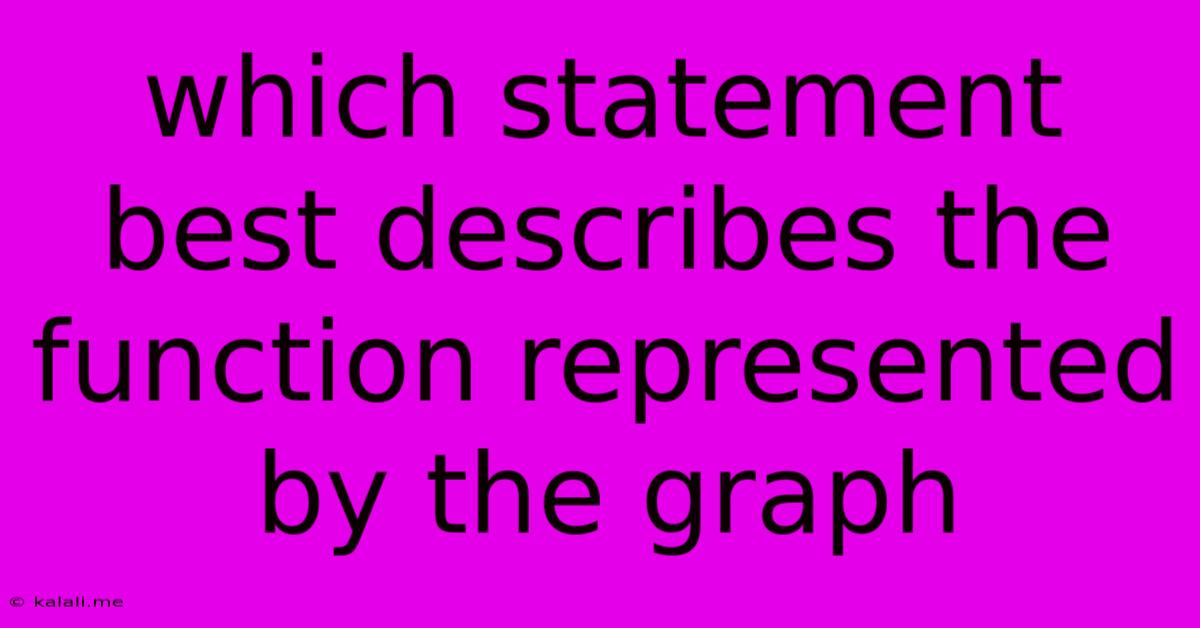Which Statement Best Describes The Function Represented By The Graph
Kalali
May 10, 2025 · 3 min read

Table of Contents
Which Statement Best Describes the Function Represented by the Graph? A Comprehensive Guide
This article will guide you through the process of analyzing graphs and selecting the statement that best describes the underlying function. Understanding how to interpret graphical representations of functions is crucial in mathematics and various scientific fields. We'll cover different types of functions and the key features to look for when determining the best description. This guide will equip you with the skills to confidently answer questions like "Which statement best describes the function represented by the graph?"
Understanding Function Representation
A function, in simple terms, is a relationship between inputs (often denoted as 'x') and outputs (often denoted as 'y'), where each input has only one unique output. Graphs visually represent this relationship. The x-axis typically represents the input, and the y-axis represents the output. The graph itself shows the relationship between these inputs and outputs. To determine which statement best describes the function, we need to analyze several key characteristics of the graph.
Key Features to Analyze
Several key features will help you determine which statement accurately describes the function:
- Linearity: Is the graph a straight line? If yes, it represents a linear function. The equation will be of the form y = mx + c, where 'm' is the slope and 'c' is the y-intercept.
- Non-linearity: If the graph is not a straight line, it represents a non-linear function. This could be a quadratic (parabola), cubic, exponential, logarithmic, or other type of function.
- Slope: For linear functions, the slope indicates the rate of change. A positive slope means the function is increasing, a negative slope means it's decreasing, and a zero slope means it's constant.
- Intercepts: The x-intercept is where the graph crosses the x-axis (y=0), and the y-intercept is where it crosses the y-axis (x=0). These points provide valuable information about the function.
- Asymptotes: Some functions approach but never reach certain values. These values represent asymptotes, either horizontal or vertical.
- Increasing/Decreasing Intervals: Identify the intervals of x-values where the function is increasing (y-values get larger as x increases) or decreasing (y-values get smaller as x increases).
- Maxima and Minima: Look for points where the function reaches a maximum or minimum value within a specific interval. These are often turning points.
- Domain and Range: The domain is the set of all possible x-values, and the range is the set of all possible y-values. Identifying these helps clarify the function's behavior.
Examples and Analysis
Let's consider a few examples:
Example 1: A Straight Line with Positive Slope
A graph showing a straight line that rises from left to right indicates a linear function with a positive slope. The best-describing statement would be something like: "The function represents a linear relationship with a positive rate of change."
Example 2: A Parabola Opening Upwards
A U-shaped graph (parabola) opening upwards represents a quadratic function with a positive leading coefficient. The best statement might be: "The function is a quadratic function with a minimum value."
Example 3: An Exponential Curve
A graph that shows rapid, increasing growth could represent an exponential function. A suitable description would be: "The function exhibits exponential growth."
Choosing the Best Statement
When presented with multiple choices, carefully examine the graph and compare its features to the descriptions provided. Eliminate options that don't align with the graph's characteristics. The best statement will accurately reflect the function's type, behavior (increasing, decreasing, constant), intercepts, and any other significant features observed on the graph.
Conclusion
Determining the function represented by a graph requires a systematic approach. By understanding the key features of different types of functions and carefully analyzing the graph, you can confidently choose the statement that best describes the function's behavior and characteristics. Remember to consider linearity, slope, intercepts, asymptotes, and the overall shape of the graph to make an informed decision.
Latest Posts
Latest Posts
-
Failed To Restart Ssh Service Unit Ssh Service Not Found
Jun 01, 2025
-
Why Didnt Dumbledore Tell Harry About Snape
Jun 01, 2025
-
How To Change Print Speed On Ender 3v3 V2
Jun 01, 2025
-
How To Remove Company Monitoring From My Personal Phone
Jun 01, 2025
-
2 3 Way Switches 2 Lights
Jun 01, 2025
Related Post
Thank you for visiting our website which covers about Which Statement Best Describes The Function Represented By The Graph . We hope the information provided has been useful to you. Feel free to contact us if you have any questions or need further assistance. See you next time and don't miss to bookmark.